Practicing the Intermediate 2nd Year Maths 2B Textbook Solutions Inter 2nd Year Maths 2B Circle Solutions Exercise 1(d) will help students to clear their doubts quickly.
Intermediate 2nd Year Maths 2B Circle Solutions Exercise 1(d)
I.
Question 1.
Find the condition that the tangents drawn from (0, 0) to S ≡ x² + y² + 2gx + 2fy + c = 0 be perpendicular to each other.
Solution:
If θ is the angle between the pair of tangents from P1 then tan \(\frac{\theta}{2}=\frac{r}{\sqrt{s_{11}}}\)

g² + f² – c = c
g² + f² = 2c
This is the required condition.
Question 2.
Find the chord of contact of (0, 5) with respect to the circle x² + y² – 5x + 4y – 2 = 0
Solution:
Equation of the chord of contact is S1 = 0
i.e., xx1 + yy1 + g(x + x1) + f(y + y1) + c = 0
Equation of the circle is
S = x² + y² – 5x + 4y – 2 = 0
Equation of the chord of contact is
x. 0 + y. 5 – \(\frac{5}{2}\) (x + 0) + 2(y + 5) – 2 = 0
Multiplying with 2
10y – 5x + 4y + 20 – 4 = 0 – 5x + 14y +16 = 0
or 5x – 14y – 16 = 0
Question 3.
Find the chord of contact of (1, 1) to the circle x² + y² = 9.
Solution:
Equation of the circle is x² + y² = 9
Equation of the chord of contact is
x.1 + y. 1 =9
i.e. x + y = 9
![]()
Question 4.
Find the polar of (1, 2) with respect to x² + y² = 7.
Solution:
Polar of P(x1, y1) w.r. to S = 0
xx1 + yy1 = a²
x + 2y – 7 = 0 is the polar equation.
Question 5.
Find the polar of (3, -1) with respect to 2x² + 2y² = 11.
Solution:
Equation of circle is 2x² + 2y² = 11
x² + y² = \(\frac{11}{2}\)
Equation of polar is xx1 + yy1 = a²
x(3) + y(-1) = \(\frac{11}{2}\)
Equation-of polar is 6x – 2y -11 = 0
Question 6.
Find the polar of (1, -2) with respect to x² + y² – 10x – 10y + 25 = 0
Solution:
Equation of the circle is
x² + y² – 10x – 10y + 25 = 0
Equation of the polar is S1 = 0
Polar of P(1, -2) is
x .1 + y(-2) – 5(x + 1) – 5(y – 2) + 25 = 0
⇒ x – 2y – 5x – 5 – 5y + 10 + 25 = 0
⇒ -4x – 7y + 30 = 0
∴ 4x + 7y – 30 = 0
Question 7.
Find the pole of ax + by + c = 0 (c + 0) with respect to x² + y² = r².
Solution:
Let (x1, y1) be pole, the polar equation be
xx1 + yy1 – r² = 0 ………… (i)
ax + by + c = 0 ………….. (ii)
(i) and (ii) both are same (polar) equations.
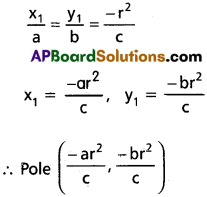
Question 8.
Find the pole of 3x + 4y – 45 = 0 with respect to x² + y² – 6x – 8y + 5 = 0.
Solution:
Equation of polar is
xx1 + yy1 – 3(x + x1) – 4(y + y1) + 5 = 0
x(x1 – 3) + y(y1 – 4) – 3x1 – 4y1 + 5 = 0 ……….. (i)
Polar equation is same 3x + 4y – 45 = 0 ……….. (ii)
Comparing (i) and (ii) we get
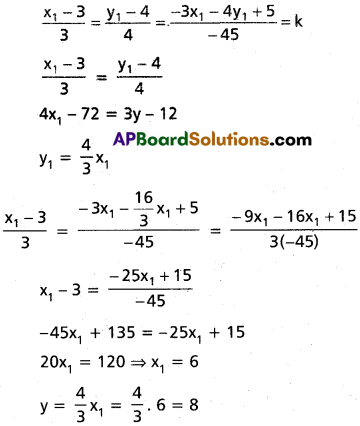
Pole is (6, 8).
Question 9.
Find the pole of x – 2y + 22 = 0 with respect to x² + y² – 5x + 8y + 6 = 0.
Solution:
Polar equation is
xx1 + yy1 – \(\frac{5}{2}\)(x + x1) + 4(y + y1) + 6 = 0
(or) x(x1 – \(\frac{5}{2}\)) + y(y1 + 4) – \(\frac{5}{2}\)
x1 + 4y1 + 6 = 0 …………. (i)
x – 2y + 22 = 0 ………….. (ii)
(i) and (ii) both are equations of the same line comparing it we get

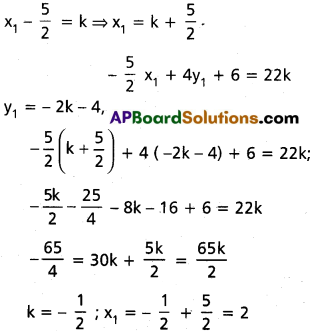
y1 = -3
∴ Pole is (2, -3)
Question 10.
Show that the points (-6, 1) and (2, 3) are conjugate points with respect to the circle x² + y² – 2x + 2y + 1 =0.
Solution:
Polar equation w.r.t. (2, 3) is
2x + 3y – 1(x + 2) + 1(y + 3) + 1 = 0
x + 4y + 2 = 0 ………. (i)
Now (-6, 1) should satisfy equation (i) if it is conjugate point
(-6) + 4(1) + 2 = 0
∴ (-6, 1) and (2, 3) are conjugate w.r.t. circle.
![]()
Question 11.
Show that the points (4, 2) (3, -5) are conjugate points with respect to the circle x² + y² – 3x – 5y + 1 = 0.
Solution:
Polar equation w.r.t. (4, 2) is
4x + 2y – \(\frac{3}{2}\)(x + 4) – \(\frac{5}{2}\)(y + 2) + 1 = 0 ………. (i)
Now (3, -5) should satisfy equation (i) if it is conjugate points.
4(3) – 5 × 2 – \(\frac{3}{2}\)(3 + 4) – \(\frac{5}{2}\)(-5 + 2) + 1
12 – 10 – \(\frac{21}{2}\) + \(\frac{15}{2}\) + 1 = 0
Hence given points are conjugate.
Question 12.
Find the value of k if kx + 3y – 1 = 0, 2x + y + 5 = 0 are conjugate lines with respect to the circle x² + y² – 2x – 4y – 4 = 0.
Solution:
Let pole be (x1, y1) polar equation w.r.t.
x² + y² – 2x – 4y – 4 = 0 be
xx1 + yy1 -1 (x + x1) – 2(y + y1) – 4 = 0
x(x1 – 1) + y(y1 – 2) – x1 – 2y1 – 4 = 0 …….. (i)
2x + y + 5 = 0 is polar so comparing with equation (i) we get

x1 = -1, y1 = 1 Pole (-1, 1)
kx + 3y – 1 = 0 is polar so it should satisfy
(1, 1)
k(-1) + 3(1) – 1 = 0
-k + 2 = 0
k = 2
Question 13.
Find the value of k if x + y – 5 = 0, 2x + ky – 8 = 0 are conjugate with respect to the circle x² + y² – 2x – 2y – 1 = 0.
Solution:
If l1x + m1y + n1 = 0; l2x + m2y + n2 = 0 are conjugate, S = 0 then,
r²(l1l2 + m1m2)
= (l1g + m1f – n1) (l2g + m2f – n2)
l1 = 1, m1 = 1, n1 = -5
l2 = 2, m2 = k, n2 = – 8
g = -1, f = -1, r² = 3
∴ 3(1.2 + k) = (-1 -1 + 5) (-2 – k + 8)
6k = 18 – 6 = 12 ⇒ k = 2
Question 14.
Find the value of k if the points (1, 3) and (2, k) are conjugate with respect to the circle x² + y² = 35.
Solution:
Equation of the circle is x² + y² = 35
Polar of P(1, 3) is x. 1 + y. 3 = 35
x + 3y = 35
P(1, 3) and Q(2, k) are conjugate points The polar of P passes through Q
2 + 3k = 35
3k = 33
k = 11
Question 15.
Find the value of k if the points (4, 2) and (k, -3) are conjugate points with respect to the circle x² + y² – 5x + 8y + 6 = 0.
Solution:
Equation of the circle is x² + y² – 5x + 8y + 6 = 0
Polar of P(4, 2) is
x.4 + y.2 – \(\frac{5}{2}\)(x + 4) + 4(y + 2) + 6 = 0
8x + 4y – 5x – 20 + 8y + 16 + 12 = 0
3x + 12y + 8 = 0
P(4, 2), Q(k, -3) are conjugate points
Polar of P passes through Q
∴ 3k – 36 + 8 = 0
3k = 28 ⇒ k = \(\frac{28}{2}\)
II.
Question 1.
Find the angle between the tangents drawn from (3, 2) to the circle x² + y² – 6x + 4y – 2 = 0.
Solution:
Equation of the circle is
S ≡ x² + y² – 6x + 4y – 2 = 0
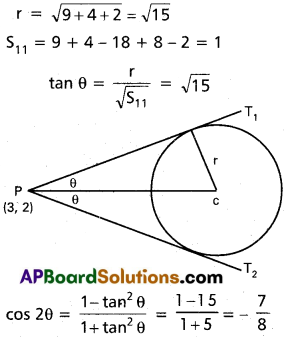
Angle between the tangent at P = cos-1 (\(\frac{7}{8}\))
![]()
Question 2.
Find the angle between the pair of tangents dravyn from (1, 3) to the circle x² + y² – 2x + 4y – 11 = 0.
Solution:
Equation of the circle is
S1 ≡ x² + y² – 2x + 4y – 11 = 0
r = \(\sqrt{1+4+11}\) = 4
S11 =1 +9-2 + 12-11 = 9

Angle between the tangents = cos-1 (\(\frac{7}{25}\))
Question 3.
Find the angle between the pair of tangents drawn from (0,0) to the circle x² + y² – 14x + 2y + 25 = 0.
Solution:
Equation of the circle is
x² + y² – 14x + 2y + 25 = 0
r = \(\sqrt{49+1-25}\) = 5
S11 = 0 + 0 – 0 + 0 + 25 = 25 ⇒ √S11 = 5
tan θ = \(\frac{r}{\sqrt{s_{11}}}\) = \(\frac{5}{5}\) = 1 ⇒ θ = \(\frac{\pi}{4}\)
Angle between the tangents = 2θ = \(\frac{\pi}{2}\)
Question 4.
Find the locus of P if the tangents drawn from P to x² + y²= a² include an angle α.
Solution:
Equation of the circle is x² + y² = a²
r = radius = a
Suppose θ (x1, y1) is any point as the locus
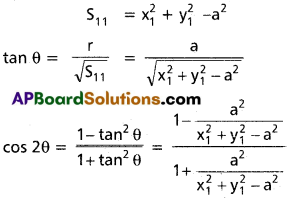
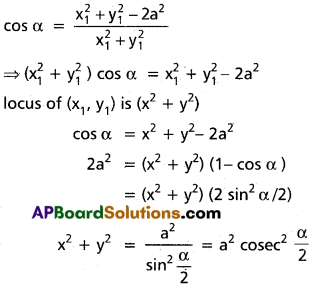
Question 5.
Find the locus of P if the tangents drawn from P to x2 + y2= a2 are perpendicular to each other.
Solution:
Equation of the circle is x² + y² = a²
r = a
Let P(x1, y1) be any point on the locus
S11 = x²1 + y²1 – a²

Squaring and cross-multiplying
a² = x² + y² – a²
x² + y² = 2a²
Locus of P (x1, y1) is x² + y²= 2a²
Question 6.
Find the slope of the polar of (1, 3) with respect to the circle x² + y² – 4x – 4y – 4= 0. Also find the distance from the centre to it.
Solution:
Equation of the circle is x² + y² – 4x – 4y – 4 =0
Polar of P (1, 3) is
x.1 + y.3 – 2(x + 1) – 2(y + 3) – 4 = 0
x + 3y – 2x – 2 – 2y – 6 – 4 = 0
-x + y – 12 = 0
Slope of the polar is – \(\frac{a}{b}=\frac{1}{1}\) = 1
Distance from the centre

Question 7.
If ax + by + c = 0 is the polar of (1, 1) with respect to the circle x² + y² – 2x + 2y +1=0 and H.C.F. of a, b, c is equal to one then find a² + b² + c².
Solution:
Equation of the circle is
x2+ y2-2x + 2y +1 = 0
Polar of (1, 1) w.r.to the circle is
x.1 + y.1 -(x + 1) + (y + 1) + 1 = 0
x + y – x – 1 + y + 1 + 1 = 0
2y + 1 = 0 …………. (1)
Given equation of the line ax + by + c = 0 ……….. (2)
Comparing (1) and (2)
\(\frac{a}{0}=\frac{b}{2}=\frac{c}{1}\) = k
a = 0, b = 2k, c = k
a² + b² + c² = 0 + 4k² + k² = 5k²
H.C.F of (a, b, c) = 1 ⇒ k = 1
a² + b² + c2 = 5(1)² = 5
III.
Question 1.
Find the coordinates of the point of in-tersection of tangents at the points where x + 4y – 14 = 0 meets the circle x² + y² – 2x + 3y – 5 = 0.
Solution:
Equation of the given circle is
x² + y² – 2x + 3y – 5 = 0
polar of P(x1, y1) is
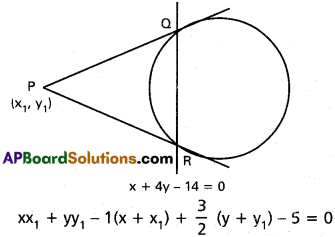
2xx1 + 2yy1 – 2x – 2x1 + 3y + 3y1 – 10 = 0
2(x1 – 1)x + (2y1 + 3)y – (2x1 – 3y1 + 10) = 0 ……….. (1)
Equation of QR is x + 4y – 14 = 0 ……… (2)
Comparing (1) and (2)

∴ Co-ordinates of p are (\(\frac{109}{76}\), \(\frac{9}{38}\))
Question 2.
If the polar of the points on the circle x² + y² = a² with respect to the circle x² + y² = b² touches the circle x² + y² = c² then prove that a,b,c are in Geometrical progression.
Solution:
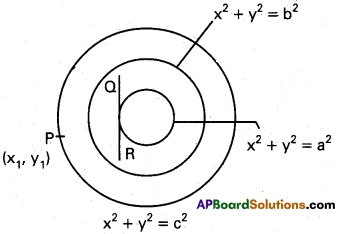
P(x1, y1) is a point on the circle x² + y² = a²
∴ x²1 + y²1 = a² ……. (1)
Polar of P w.r.to the circle x²+ y² = b² is xx1 + yy1 = b²
There is a tangent to the circle x² + y² = c²

Cross – multiplying we get b2 = ac
∴ a, b, c are in Geometric progression.
![]()
Question 3.
Tangents are drawn to the circle x² + y² = 16 from the point P(3, 5). Find the area of the triangle formed by these tangents and the chord of contact of P.
Solution:
Equation of the circle is x² + y² = 16
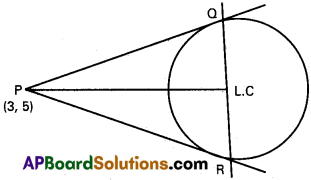
Polar of P (3, 5) is 3x + 5y = 16
PL = Length of the perpendicular from P
\(\frac{|9+25-16|}{\sqrt{9+25}}=\frac{18}{\sqrt{34}}\)
Centre of the circle = C (0, 0)
P = Length of the perpendicular from c
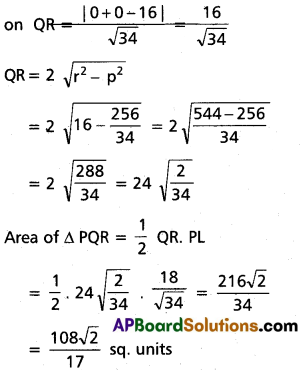
Question 4.
Find the locus of the point whose polars with respect to the circles x² + y² – 4x – 4y – 8 = 0 and x² + y² – 2x + 6y – 2 = 0 are mutually perpendicular.
Solution:
Suppose P(x, y) is any position the locus Equation of the circles are
x² + y² – 4x – 4y – 8 = 0 ………….. (1)
x² + y² – 2x + 6y – 2 = 0 …………. (2)
Equation of the polar of P w.r.to circle (1) is
xx1 + yy1 – 2(x + x1) – 2(y + y1) – 8 = 0
x(x1 – 2) + y(y1 – 2) – (2x1 +2y1 + 8) = 0 ………… (3)
Polar of P w.r. to circle (2) is
xx1 + yy1 – 1(x + x1) – 3(y + y1) – 2 = 0
xx1 + yy1 – x – x1 + 3y + 3y1 – 2 = 0
x(x1 – 1) + y(y1 + 3) – (x1 + 3y1 + 2) = 0 ………. (4)
(3) and (4) are perpendicular 0
⇒ a1a2 + b1b2
(x1 – 2) (x1 – 1) + (y1 – 2) (y1 + 3) = 0
x²1 – 3x1 + 2 + y²1 + y1 – 6 = Q
x²1 + y²1 – 3x1 + y1 – 4 = 0
Locus of p(x1, y1) is x² + y² – 3x+ y – 4 = 0
![]()
Question 5.
Find the locus of the foot of the perpen¬dicular drawn from the origin to any chord of the circle S ≡ x² + y² + 2gx + 2fy + c = 0 which subtends a right angle at the origin.
Solution:
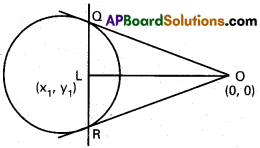
Suppose L (x1, y1) is the foot of the per-pendicular from the origin on the chord QL
Slope a QL = \(\frac{y_{1}}{x_{1}}\)
Slope of QR = \(\frac{x_{1}}{y_{1}}\)
Equation of QR is y – y1 = \(\frac{x_{1}}{y_{1}}\)(x – x1)
yy1 – y²1 = -xx1 + x²1
xx1 + yy1 = x²1 + y²1
or \(\frac{xx_{1}+yy_{1}}{x_{1}^{2}+y_{1}^{2}}\) = 1 …………. (1)
Equation of the circle is
x² + y² + 2gx + 2fy + c = 0 …………. (2)
Hamogenising (2) with the help of (1), combined equation of
QQ, OR is x² + y² + (2gx + 2fy)
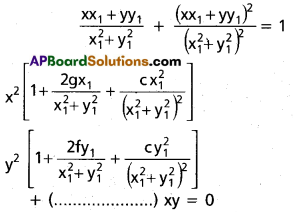
OQ, OR are perpendicular
Co – eff. of x² + co- eff of y² = 0
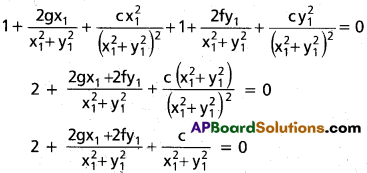
2(x²1 + y²1) + 2gx1 + 2fy1 + c =
Locus of L (x1, y1)is
2(x² + y²) + 2gx + 2fy + c = 0